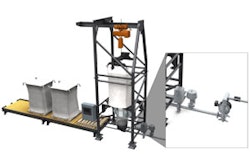WASHINGTON (AP) — Top Nuclear Regulatory Commission officials debated the accuracy of public statements made by the agency's chairman about a pool holding spent fuel rods at a crippled Japan nuclear plant, newly released transcripts show.
NRC Chairman Gregory Jaczko told Congress the pool was dry, which would have increased the chances of a catastrophic radioactive release. The claim — which drew immediate denials from Japanese officials and later proved to be wrong — was a key reason for a U.S. recommendation that Americans within 50 miles of the plant leave the area.
After Jaczko's testimony, a top NRC official in Japan told Jaczko his statement was "probably inaccurate."
The official later said he was unsure, telling Jaczko: "It may not have been dry, but it certainly wasn't full" of water.
The NRC on Tuesday released more than 3,000 pages of transcripts showing the agency's response in the days following the March 11, 2011, earthquake and tsunami in Japan, which triggered the worst nuclear crisisin a quarter century. The release was made in response to requests under the Freedom of Information Act from The Associated Press and other news organizations.
The transcripts, some redacted, show what Jaczko called a "fog of war" atmosphere as officials struggled to get accurate information.
"The early hours ... were very hectic," Jaczko told reporters Tuesday in a brief conference call as his agency released the transcripts. Much of what officials learned came from counterparts in Japan and an international nuclear agency, "and a great deal came from the news media," Jaczko said.
Jaczko did not take questions and his remarks did not address his previous claims on the spent-fuel pool. Loss of cooling water in the reactor core could have exposed highly radioactive spent fuel rods, increasing the threat of a complete fuel meltdown and a catastrophic release of radiation.
Japanese officials denied the pool was dry and reported that the plant's condition was stable.
NRC officials later acknowledged that Jaczko spoke in error.
The transcripts released Tuesday show a worried Jaczko repeatedly asking whether his statements about the spent-fuel pool were accurate.
On March 16, for example, Jaczko asked his top-ranking aide in Japan, Charles Casto: "At this point, you no longer believe that the pool is dry?"
"I would say, as of five o'clock yesterday, the pool has some water in it," Casto replied.
"Okay. Now I've said publicly the pool is dry," Jaczko said.
"Yes, I know that," Casto said. "I would say it's probably inaccurate to say it's dry."
Later, another NRC official told Jaczko that Japanese officials who initially had indicated the pool was dry had changed their minds.
"That's great," Jaczko replied.
In the documents, Casto repeatedly expressed frustration at the limited information provided by Japaneseofficials, saying at one point they were relying on a short video of the plant made by helicopter. "So we really don't know what the hell we looked at," he said. "All we can tell is some feet away, there was steam coming out of the building."
A key focus in the days after the disaster was how U.S. citizens in Japan should respond, the transcripts show.
Bill Borchardt, the NRC's executive director for operations, assured Jaczko that he was on solid footing in recommending a 50-mile evacuation zone for U.S. citizens in Japan. The evacuation zone was five times larger than U.S. nuclear plants' plan for in emergencies. The 50-mile zone also was greater than Japanese officialsrecommended for their own citizens.
"If this happened in the U.S., we would go out to 50 miles," Borchardt told Jaczko on March 16. "That would be our evacuation recommendation."
The transcript also shows that U.S. officials quickly recognized the scope of the disaster. "At this point I would see a worst scenario probably being three reactors eventually having, for lack of a better term, a meltdown," Jaczko told White House officials. The statement correctly predicted the outcome of the disaster, the world's worst nuclear crisis since Chernobyl in 1986.
The NRC has since approved a number of steps to improve safety at U.S. nuclear plants. The changes are intended to make the 104 U.S. commercial nuclear reactors better prepared for incidents they were not initially designed to handle, such as prolonged power blackouts or damage to multiple reactors at the same time, as happened in Japan.






















